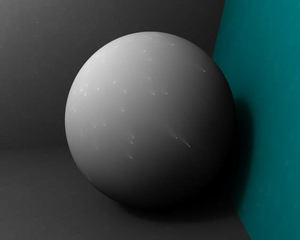Information
- Publication Type: Bachelor Thesis
- Workgroup(s)/Project(s):
- Date: August 2018
- Date (Start): 1. January 2018
- Date (End): 7. August 2018
- Matrikelnummer: 01227129
- First Supervisor:
- Keywords: global illumination, virtual point lights
Abstract
This thesis documents the full implementation of the method Virtual Ray Lights for Rendering Scenes with Participating Media. As a basic understanding of the foundations of rendering and related approaches is necessary to understand this complex method, these foundations are discussed first. There, the rendering equation and the physical behaviour of light is described. Additionally, rendering approaches like Recursive Ray Tracing and Photon Mapping that do not consider participating media, as well as methods like Volumetric Photon Mapping, Virtual Point Lights and Photon Beams, which are able to render participating media, are evaluated. For the discussion on Virtual Ray Lights, the evaluation takes place in three parts. First, the method is discussed in general with a mathematical analysis. Afterwards, implementation details are evaluated where pseudocode examples are provided. Lastly, the rendered results of the implementation are evaluated thoroughly. These results are also compared to provided images from various research papers. The goal of this thesis is to provide an implementation of Virtual Ray Lights, as well as providing the tools to implement this method in other projects. We provide the well-documented source code for this project, with the scene settings to recreate the examples.Additional Files and Images
Weblinks
No further information available.BibTeX
@bachelorsthesis{OPPTIZ-2018-IVRL,
title = "Implementing Virtual Ray Lights for Rendering Scenes with
Participating Media",
author = "Michael Oppitz",
year = "2018",
abstract = "This thesis documents the full implementation of the method
Virtual Ray Lights for Rendering Scenes with Participating
Media. As a basic understanding of the foundations of
rendering and related approaches is necessary to understand
this complex method, these foundations are discussed first.
There, the rendering equation and the physical behaviour of
light is described. Additionally, rendering approaches like
Recursive Ray Tracing and Photon Mapping that do not
consider participating media, as well as methods like
Volumetric Photon Mapping, Virtual Point Lights and Photon
Beams, which are able to render participating media, are
evaluated. For the discussion on Virtual Ray Lights, the
evaluation takes place in three parts. First, the method is
discussed in general with a mathematical analysis.
Afterwards, implementation details are evaluated where
pseudocode examples are provided. Lastly, the rendered
results of the implementation are evaluated thoroughly.
These results are also compared to provided images from
various research papers. The goal of this thesis is to
provide an implementation of Virtual Ray Lights, as well as
providing the tools to implement this method in other
projects. We provide the well-documented source code for
this project, with the scene settings to recreate the
examples.",
month = aug,
address = "Favoritenstrasse 9-11/E193-02, A-1040 Vienna, Austria",
school = "Institute of Computer Graphics and Algorithms, Vienna
University of Technology ",
keywords = "global illumination, virtual point lights",
URL = "https://www.cg.tuwien.ac.at/research/publications/2018/OPPTIZ-2018-IVRL/",
}

 thesis
thesis

